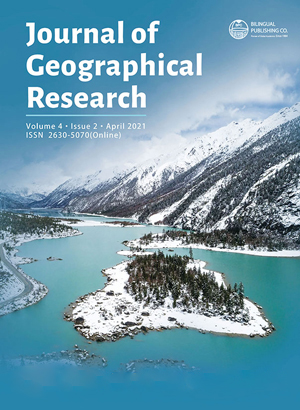-
1400
-
382
-
296
-
228
-
187
Floodplain Mapping and Risks Assessment of the Orashi River Using Remote Sensing and GIS in the Niger Delta Region, Nigeria
DOI:
https://doi.org/10.30564/jgr.v4i2.3014Abstract
Residents along the shoreline of the Orashi River have yearly been displaced and recorded loss of lives,farmland,and infrastructures. The Government’s approach has been the provision of relief materials to the victims instead of implementing adequate control measures.This research employs Shuttle Radar Topographic Mission and Google Earth imagery in developing a 3D floodplain map using ArcGIS software. The result indicates the drainage system in the study area is dendritic with catchment of 79 subbasins and 76 pour point implying the area is floodplain .Incorporating the 3D slope which reveals that> 8 and <8 makes up 1.15% and 98.85% of the study area respectively confirms the area is a floodplain. Aspect indicate west-facing slope are dark blue, 3D hillshade indicate yellow is very low area and the high area is pink and also the buffer analysis result reveals waterbodies reflecting blue with an estimated area of 1.88 km2,yellow indicate 0.79 km2 of the shoreline, red indicate 0.81 km2 of the minor floodplain and pink contain 0.82 km2 with the length of 32.82 km. The result from google earth image in 2007 indicate absent of settlement, 2013 indicate minimal settlement and 2020 indicate major settlement in the study area when correlated with 3D Floodplain mapping before and during the flood in other to analyze and manage flooding for further purpose and the majority of the area are under seize with flood like in 2020. Therefore, Remote Sensing and GIS techniques are useful for Floodplain mapping, risk analysis for control measures for better flood management.
Keywords:
3D floodplain; Flood hazard assessment; SRTM; GIS; Remote sensing; Flood management; BufferReferences
[1] Adewale Adebayo, Uwaezuoke Ifeanyichukwu Christian (2019). Floodplain mapping of Rima River Using GIS and Remote Sensing (Argungu Axis, Nigeria): Journal of Environmental Science,Toxicology and Food Technology (IOSR-JESTFT) e-ISSN: 2319-2402, p- ISSN:2319-2399.Volume 13, Issue 12; PP 28-35.
[2] Eteh Desmond Rowland and Akana Tombra Susan (2020). Flood simulation and Terrain Analysis between 2018 and 2019 in the Niger Delta: A case study of Yenagoa and its environs. International Research Journal of Modernization in Engineering Technology and Science. Volume:02.DOI:https://doi.org/10.12691/env-3-3-3.
[3] Eteh Desmond, Francis Emeka Egobueze and Francis Omonefe. (2019): Determination of Flood Hazard Zones Using Geographical Information Systems and Remote Sensing Techniques: A Case Study in Part Yenagoa Metropolis. Journal of Geography Environment and Earth Science International 21(1):1-9.DOI: https://doi.org/10.9734/jgeesi/2019/v21i130116.
[4] Goudie, A. S. (2005). The drainage of Africa since the Cretaceous. Geomorphology, 67(3-4),437–456.DOI: https://doi.org/10.1016/j.geomorph.2004.11.008.
[5] Heimhuber, J.- C. Hannemann, and W. Rieger,(2015). Flood risk management in remote and impoverished areas; a case study of Onaville, Haiti,Water, vol. 7, no. 7, pp. 3832-3860.
[6] Reijers, T. J. A. (2011). Stratigraphy and Sedimentology of the Niger Delta. Geologic, The Netherlands, 17(3), p.133-162.
[7] Reyment R. A. (2018). Ammonito logist sensulatissimo: founder of Cretaceous Research Bengtson,P.Cretaceous Research-1926-2016,88, 5-35.
[8] World Population Prospects (2017) Retrieved 2017-11-21.
[9] https://www.portharcourtblog (2020).
Downloads
How to Cite
Issue
Article Type
License
Copyright © 2021 Eteh Desmond Rowland

This is an open access article under the Creative Commons Attribution-NonCommercial 4.0 International (CC BY-NC 4.0) License.




 Eteh Desmond Rowland
Eteh Desmond Rowland





